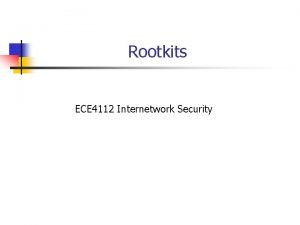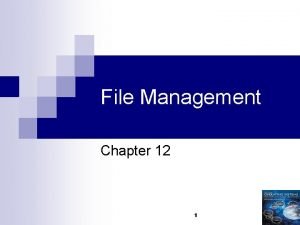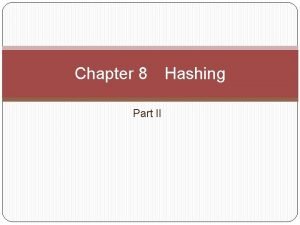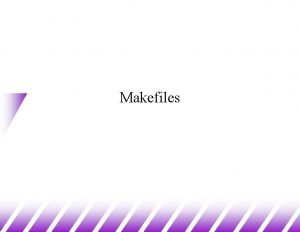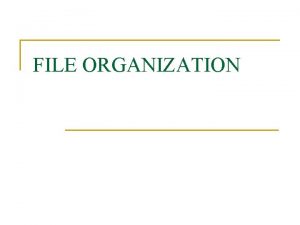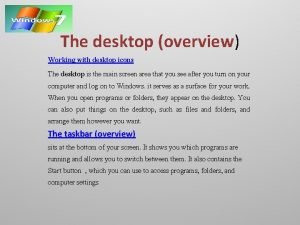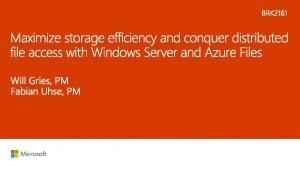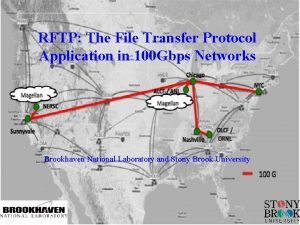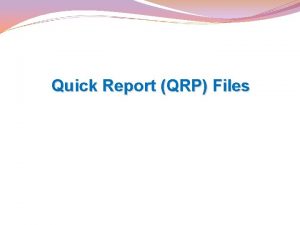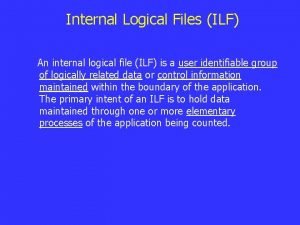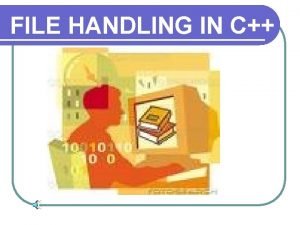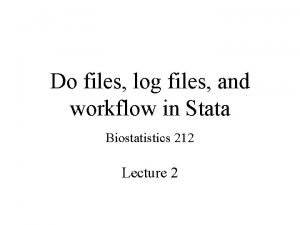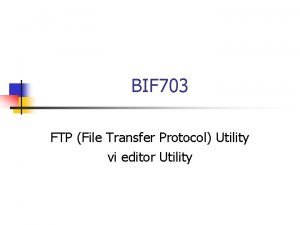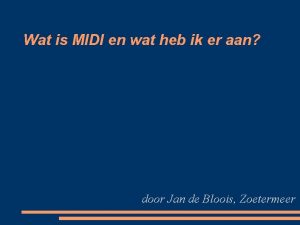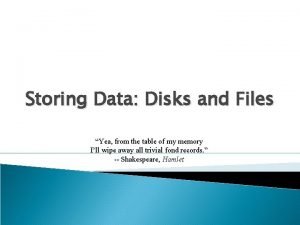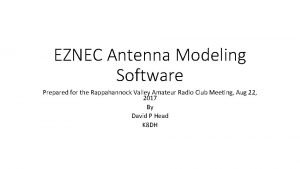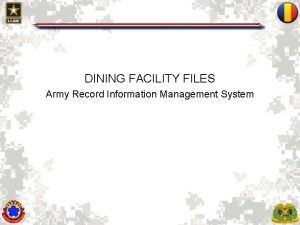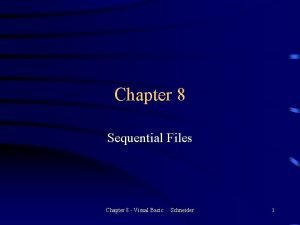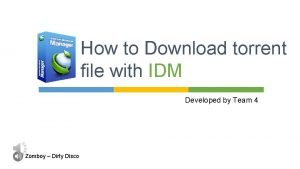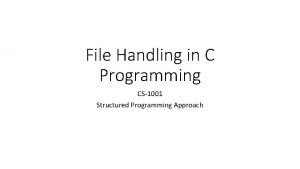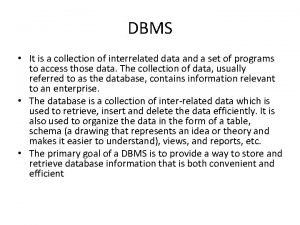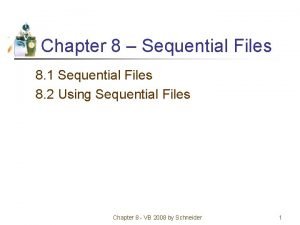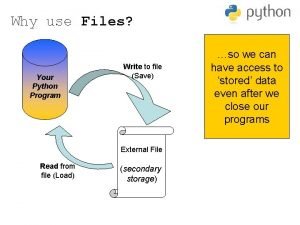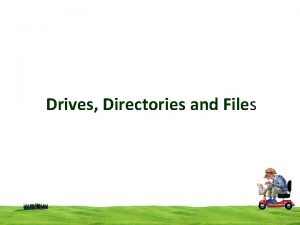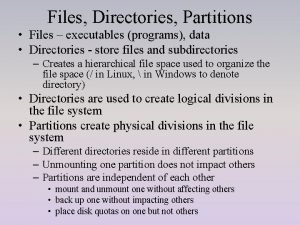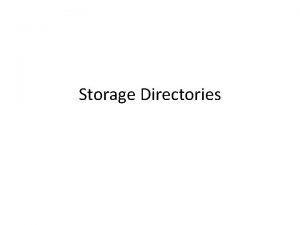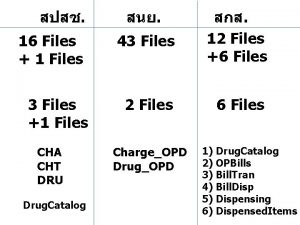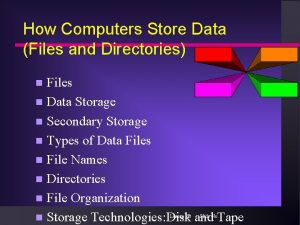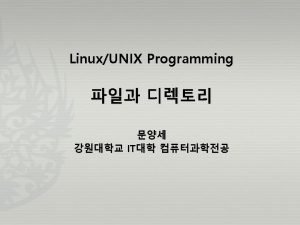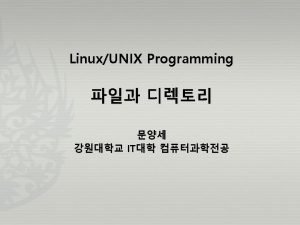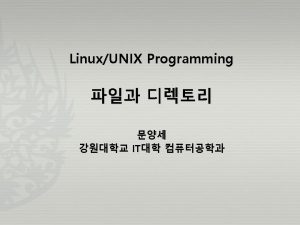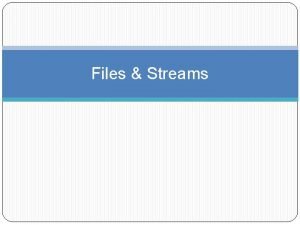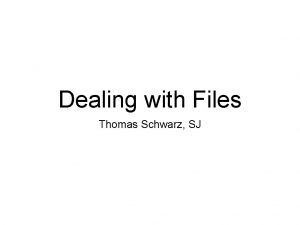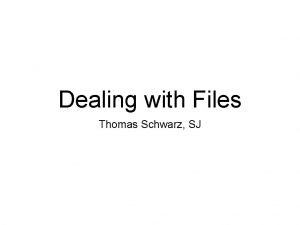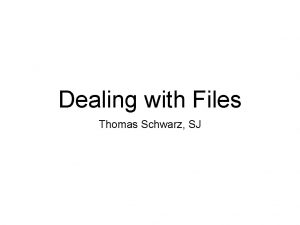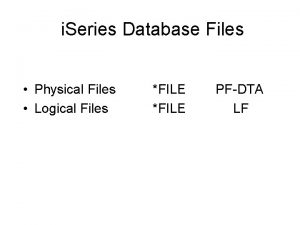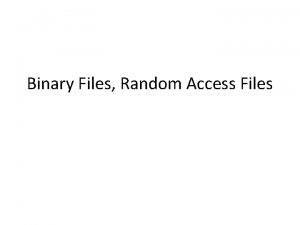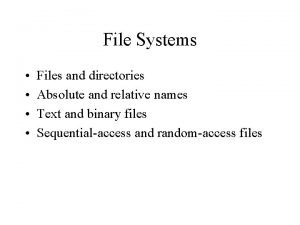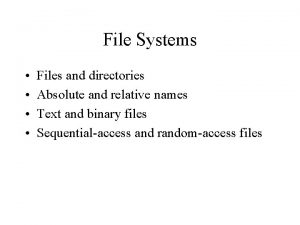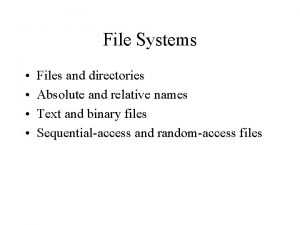Files and Directories Files and Directories 1 u

















![Working with Directories (3) u Move a file from one directory to another obelix[1] Working with Directories (3) u Move a file from one directory to another obelix[1]](https://slidetodoc.com/presentation_image_h/1485f0bd2633ef2230acb16c711113b6/image-18.jpg)
![Working with Directories (4) u Copy a file from one directory to another obelix[1] Working with Directories (4) u Copy a file from one directory to another obelix[1]](https://slidetodoc.com/presentation_image_h/1485f0bd2633ef2230acb16c711113b6/image-19.jpg)




![More Files and Directories (3) obelix[56] > tail -8 my_new_file breaksw tail displays the More Files and Directories (3) obelix[56] > tail -8 my_new_file breaksw tail displays the](https://slidetodoc.com/presentation_image_h/1485f0bd2633ef2230acb16c711113b6/image-24.jpg)






![Filename Wildcarding (2) u Wildcard sequences can be combined obelix[6] > mv a*. [ch] Filename Wildcarding (2) u Wildcard sequences can be combined obelix[6] > mv a*. [ch]](https://slidetodoc.com/presentation_image_h/1485f0bd2633ef2230acb16c711113b6/image-31.jpg)

![Filename Wildcarding (4) u More advanced examples: – What does the following do? obelix[10] Filename Wildcarding (4) u More advanced examples: – What does the following do? obelix[10]](https://slidetodoc.com/presentation_image_h/1485f0bd2633ef2230acb16c711113b6/image-33.jpg)







![FTP (1) u FTP File Transfer Protocol obelix[1] > ftp gaul. csd. uwo. ca FTP (1) u FTP File Transfer Protocol obelix[1] > ftp gaul. csd. uwo. ca](https://slidetodoc.com/presentation_image_h/1485f0bd2633ef2230acb16c711113b6/image-41.jpg)

- Slides: 42

Files and Directories

Files and Directories (1) u What is a file? – a container for ordered data – persistent (stays around) and accessible by name u Unix files – regular Unix files are pretty simple vessentially a sequence of bytes vcan access these bytes in order – Unix files are identified by a name in a directory vthis name is actually used to resolve the hard disk name/number, the cylinder number, the track number, the sector, the block number – you see none of this vit allows the file to be accessed

Files and Directories (2) u Unix files come in other flavors as well, such as – Directories va file containing pointers to other files vequivalent of a “folder” on a Mac or Windows – Links va pointer to another file vused like the file it points to vsimilar to “shortcuts” in Windows, but better – Devices vaccess a device (like a soundcard, or mouse, or. . . ) like it is a file

Directories (1) u Current Working Directory – the directory you are looking at right now – the shell remembers this for you u To determine the Current Working Directory, use the command pwd (Print Working Directory) Use: obelix[18] > pwd Result: print the current working directory

Directories (2) u Moving about the filesystem – Use the “cd” (Change Directory) command to move between directories and change the current directory Use: obelix[19] > cd 211 Result: Makes cs 211 the current working directory u Listing the contents of a directory – Use the “ls” (Li. St directory) command to list the contents of a directory obelix[20] > ls tmp/ a. out* smit. script cs 211@ Link Directories Executable

Directories (3) u The upside-down tree – the Unix filesystem is organized like an upside-down tree v at the top of the filesystem is the root – write this as a lone slash: / – this is NOT a backslash (opposite of MS-DOS)! v For example, you can change to the root directory: obelix[21] > cd / obelix[22] > ls TT_DB/ dev/ bin@ devices/ cdrom/ etc/ core export/ courses@ gaul/ home/ kernel/ lib@ local/ mnt/ sbin/ net/ tmp/ opt/ usr/ platform/ var/ lost+found/ proc/ xfn/ vol/

Directories (4)

Directories (5) u Some standard directories and files in a typical Unix system – – – / /bin /devices /etc /lib /opt /proc /sbin /tmp /gaul/ the root BINaries (executables) DEVices (peripherals) where the DEVICES really live startup and control files LIBraries (really in /usr) OPTional software packages access to PROCesses Standalone BINaries place for Te. MPorary files where home directories are mounted s 0. . . s 9: different places for users

Directories (6) – – – – /usr USe. R stuff /usr/bin BINaries again /usr/include files for compilers /usr/lib LIBraries of functions etc. /usr/local stuff /usr/local/bin local BINaries /usr/local/lib local LIBraries /usr/openwin X 11 stuff /usr/sbin sysadmin stuff /usr/tmp place for more Te. MPorary files /usr/ucb UCB binaries /var VARiable stuff /var/mail the mail spool

Pathnames (1) u A typical Unix file system spans many disks – As a user you don’t know or need to know which physical disk things are on v in fact, you don’t even know which machine they are attached to: disks can be “remote” (eg: your home directory is stored on a disk attached to a server in the machine room) v Look at the df command to see different disks and space used – Inside each directory may be more directories u The Absolute Path – to identify where a file is, string the directories together v separating names with slashes: v e. g. /gaul/s 1/student/1999/csnow v this is the absolute path for my home directory v lists everything from the root down to the directory you want to specify

Pathnames (2) u When you first log in, you are in your HOME directory – To see what this is: obelix[1] > pwd /gaul/s 1/student/1999/csnow – Your home directory is also stored in the environment variable HOME obelix[2] > echo My home is $HOME My home is /gaul/s 1/student/1999/csnow – You can “Go Home” by typing obelix[3] > cd $HOME

Pathnames (3) u Some shorthand – In some shells (including tcsh, and bash), $HOME can be abbreviated as ~ (tilde) – Example: obelix[26] > cd ~/bin change to the bin directory under your home directory (equivalent to $HOME/bin) v this is where you usually store your own commands or “executables” v – To quickly go home: obelix[27]% cd with no parameters, cd changes to your home directory – ~user refers to the home directory of user For me, ~csnow is the same as ~ v ~doug refers to Doug Vancise’s home directory (/gaul/s 1/usr/faculty/doug) v

Pathnames (4) u Relative pathnames – You can also specify pathnames relative to the current working directory v This is called a relative pathname – For example obelix[28] > pwd /gaul/s 1/student/1999/csnow obelix[29] > ls tmp/ a. out* smit. script cs 211@ obelix[30] > cd tmp obelix[31] > pwd /gaul/s 1/student/1999/csnow/tmp v Note: You don’t need to know absolute pathnames u For most commands which require a file name, you can specify a pathname (relative or absolute)

Pathnames (5) u Every directory contains two “special” directories: . and. . . : another name for the current directory – e. g. cp cs 211/foo. . . : another name for the immediate parent directory of the current directory – use this to cd to your parent: obelix[32] > pwd /gaul/s 1/student/1999/csnow obelix[33] > cd. . obelix[34] > pwd /gaul/s 1/student/1999 obelix[35] > cd. . /. . obelix[36] > pwd /gaul/s 1

Pathnames (6) u You can locate a file or directory by this way: – look at the first character of the pathname v/ start from the root v. start from the current directory v. . start from the parent directory v~ start from a home directory v else start from the current directory – going down to the subdirectories in the pathname, until you complete the whole pathname. – if you start in ~csnow, the following are equivalent: v /gaul/s 1/student/1999/csnow/cs 211/readme. txt v ~/cs 211/readme. txt v cs 211/readme. txt

Working with Directories (1) u Create a directory with the mkdir command mkdir newdirname u newdirname can be given with pathname obelix[37] > pwd /gaul/s 1/student/1999/csnow/cs 211 obelix[38] > ls readme. txt obelix[39] > mkdir mydir 1 obelix[40] > ls readme. txt mydir 1/ obelix[41] > mkdir mydir 1/mydir 2 obelix[42] > ls mydir 1 Note: we can specify a directory with ls mydir 2/ obelix[43] > cd mydir 1/mydir 2

Working with Directories (2) u Remove a directory with the rmdir command rmdir dirname – dirname is the directory to remove and can be specified using a pathname – if the directory exists and is empty it will be removed u Examples: obelix[44] > cd ~/cs 211; ls readme. txt mydir 1/ obelix[45] > ls mydir 1 mydir 2/ obelix[46] > rmdir mydir 1/mydir 2 obelix[47] > ls mydir 1 obelix[48] > rmdir mydir 1 Assuming mydir 1/mydir 2 is still empty mydir 1 is now empty, so this will work fine
![Working with Directories 3 u Move a file from one directory to another obelix1 Working with Directories (3) u Move a file from one directory to another obelix[1]](https://slidetodoc.com/presentation_image_h/1485f0bd2633ef2230acb16c711113b6/image-18.jpg)
Working with Directories (3) u Move a file from one directory to another obelix[1] > pwd /gaul/s 1/student/1999/csnow/cs 211 obelix[2] > ls readme. txt mydir 1/ obelix[3] > ls mydir 1 hello. txt obelix[4] > mv mydir 1/hello. txt. obelix[5] > ls mydir 1 obelix[6] > ls readme. txt hello. txt mydir 1/ u A dot is here. You can also move a directory the same way - it is just a special file, after all.
![Working with Directories 4 u Copy a file from one directory to another obelix1 Working with Directories (4) u Copy a file from one directory to another obelix[1]](https://slidetodoc.com/presentation_image_h/1485f0bd2633ef2230acb16c711113b6/image-19.jpg)
Working with Directories (4) u Copy a file from one directory to another obelix[1] > ls readme. txt mydir 1/ obelix[2] > cp readme. txt mydir 1 obelix[3] > ls mydir 1 readme. txt u Copying a directory obelix[4] > cp mydir 1 mydir 2 cp: mydir 1: is a directory obelix[5] > cp -r mydir 1 mydir 2 obelix[6] > ls mydir 2 readme. txt Cannot use just cp to copy a directory Must do a recursive copy (cp -r) to copy a directory

Working with Directories (5) u Some shells (csh and tcsh) provide pushd and popd directory commands u pushd changes directories, but remembers the previous one by pushing it on to a stack u popd changes directories back to the last directory placed on the stack by pushd Current directory obelix[1] > pwd /gaul/s 1/student/1999/csnow obelix[2] > pushd cs 211 ~/cs 211 ~ obelix[3] > pwd /gaul/s 1/student/1999/csnow/cs 211 obelix[4] > popd ~ obelix[5] > pwd /gaul/s 1/student/1999/csnow Current directory stack: ~ was where we were Current directory stack: now empty

Working with Directories (6) u What if you need to locate a file, or set of files, in a large directory structure? – Using cd and ls would be very tedious! u The command find is used to search through directories to locate files. – Wildcards can be used, if the exact file name is unknown, or to find multiple files at once. – Can also find files based on size, owner, creation time, type, permissions, and so on. – Can also automatically execute commands on each file found. u Do a “man find” for details and examples!

More Files and Directories (1) u What files do I already have? – Startup files for csh and tcsh (. login, . cshrc) – Contain commands run after you type your password, but before you get a prompt – Assume you’ve not used your account before obelix[1] > ls obelix[2] > – Why can’t I see any files? v Files beginning with a ‘dot’ are usually control files in Unix and not generally displayed – Use the –a option to see all files obelix[3] > ls -a. /. cshrc. login obelix[4] >

More Files and Directories (2) u OK, let us study some new commands, and variations of some familiar ones obelix[51] > ls -a. /. cshrc. login obelix[52] > cp. cshrc my_new_file obelix[53] > ls -a. /. cshrc. login obelix[54] > cp -i. login my_new_file cp: overwrite my_new_file (yes/no)? y obelix[55] > head – 7 my_new_file # # WGUI is twm or mwm # if (!($? HOSTTYPE)) then set HOSTTYPE = `uname -m` endif list all files including those beginning a with. my_new_file The –i option says to ask when this overwrites existing files. head displays the top lines of a file
![More Files and Directories 3 obelix56 tail 8 mynewfile breaksw tail displays the More Files and Directories (3) obelix[56] > tail -8 my_new_file breaksw tail displays the](https://slidetodoc.com/presentation_image_h/1485f0bd2633ef2230acb16c711113b6/image-24.jpg)
More Files and Directories (3) obelix[56] > tail -8 my_new_file breaksw tail displays the last lines of a file # default: echo "**. login: Unknown Host Type **" breaksw endsw obelix[57] > rm -i my_new_file rm: remove my_new_file (yes/no)? y obelix[58] > ls –a. /. cshrc. login -i also verifies on the rm command

Unix Filenames (1) u Almost any character is valid in a file name – all the punctuation and digits – the one exception is the / (slash) character – the following are not encouraged v? * [ ] “ ” ’ ( ) &: ; ! – the following are not encouraged as the first character v- ~ – control characters are also allowed, but are not encouraged u UPPER and lower case letters are different – A. txt and a. txt are different files

Unix Filenames (2) u No enforced extensions – The following are all legal Unix file names va v a. v. a v… v a. b. c u Remember files beginning with dot are hidden – ls cannot see them, use ls -a u. and. . are reserved for current and parent directories

Unix Filenames (3) u Even though Unix doesn't enforce extensions, – “. ” and an extension are still used for clarity v. jpg for JPEG images v. tex for La. Te. X files v. sh for shell scripts v. txt for text files v. mp 3 for MP 3’s – some applications may enforce their own extensions v Compilers look for these extensions by default –. c means a C program file –. C or. cpp or. cc for C++ program files –. h for C++ header files –. o means an object file

Unix Filenames (4) u Executable files usually have no extensions – cannot execute file a. exe by just typing a – telling executable files from data files can be difficult u “file” command Use: filename Result: print the type of the file Example: obelix[1] > file ~/. cshrc: executable c-shell script u Filenames and pathnames have limits on lengths – 1024 characters typically – these are pretty long (much better than MS-DOS days and the 8. 3 filenames)

Fixing Filename Mistakes u It is very easy to get the wrong stuff into filenames – Say you accidentally typed obelix[3] > cp myfile -i Creates a file with name -i – What if you type obelix[4] > rm -i v The shell thinks -i is an option, not a file v Getting rid of these files can be painful u There is an easy way to fix this. . . – You simply type obelix[5] > rm -- -i – Many commands use “--” to say there are no more options

Filename Wildcarding (1) u Wildcarding is the use of “special” characters to represent or match a sequence of other characters – a short sequence of characters can match a long one – a sequence may also match a large number of sequences u Often use wildcard characters to match filenames – filename substitution – generally known as “globbing” u Wildcard characters * matches a sequence of zero or more characters – Example: a*. c* matches abc. c, abra. cpp, ? matches any single character – Example: a? . c matches ab. c, ax. c, but not abc. c [. . . ] matches any one character between the braces – Example: b[aei]t matches bat, bet, or bit, not baet
![Filename Wildcarding 2 u Wildcard sequences can be combined obelix6 mv a ch Filename Wildcarding (2) u Wildcard sequences can be combined obelix[6] > mv a*. [ch]](https://slidetodoc.com/presentation_image_h/1485f0bd2633ef2230acb16c711113b6/image-31.jpg)
Filename Wildcarding (2) u Wildcard sequences can be combined obelix[6] > mv a*. [ch] cfiles/ v mv all files beginning with a and ending with. c or. h into the directory cfiles obelix[7] > ls [abc]*. ? v list files whose name begins with a, b, or c and ends with. (dot) followed by a single character u Wildcards do not cross "/" boundaries – Example: csnow*c does not match csnow/codec u Wildcards are expanded by the shell, and not by the program – Programmers of commands do not worry about searching the directory tree for matching file names – The program just sees the list of files matched

Filename Wildcarding (3) u u Matching the dot – A dot (. ) at v the beginning of a filename, or v immediately following a / must be matched explicitly. – Similar to the character / – Example: obelix[8] > cat. c* cat all files whose names begin with. c As mentioned earlier, [. . ] matches any one of the characters enclosed – Within “[. . . ]”, a pair of characters separated by “-” matches any character lexically between the two v Example: lists all files beginning obelix[9] > ls [a-z]* with a character between ASCII ‘a’ and ASCII ‘z’
![Filename Wildcarding 4 u More advanced examples What does the following do obelix10 Filename Wildcarding (4) u More advanced examples: – What does the following do? obelix[10]](https://slidetodoc.com/presentation_image_h/1485f0bd2633ef2230acb16c711113b6/image-33.jpg)
Filename Wildcarding (4) u More advanced examples: – What does the following do? obelix[10] > ls /bin/*[-_]* – What about this? obelix[11] > ls * – What about this? obelix[12] > mv *. bat *. bit Answer: this one is complicated…

Unix Quoting (1) u Double Quotes: ". . " – Putting text in double quotes ". . . " stops interpretation of some shell special characters (whitespace mostly) – Examples: obelix[12] > echo Here are some words obelix[13] > echo "Here are some words" Here are some words obelix[14] > mkdir "A directory name with spaces! " obelix[15] > ls A* A directory name with spaces!/

Unix Quoting (2) u Single Quotes '. . . ' – Stops interpretation of even more specials v. Stop variable expansion ($HOME, etc. ) v. Backquotes `. . . ` (execute a command return result. . . we’ll get to this later) v. Note difference: single quote ( ' ), backquote ( ` ) v. Examples: obelix[16] > echo "Welcome $HOME" Welcome /gaul/s 1/student/1999/csnow obelix[17] > echo ‘Welcome $HOME’ Welcome $HOME

Unix Quoting (3) u Backslash – ‘quotes’ the next character – Lets one escape all of the shell special characters obelix[18] > mkdir Dir name with spaces** obelix[19] > ls Dir * Dir name with spaces**/ – Use backslash to escape a newline character obelix[20]% echo "This is a long line and we want to continue on the next“ This is a long line and we want to continue on the next – Use backslash to escape other shell special chars v Like quote characters obelix[21] > echo "Bartlett's Familiar Quotations" "Bartlett's Familiar Quotations"

Unix Quoting (4) u Control-V – Quotes the next character, even if it is a control character – Lets one get weird stuff into the command line – Very similar to backslash but generally for ASCII characters which do not show up on the screen – Example: the backspace character obelix[22] > echo "abc^H^H^Hcde" typing Control-v Control-h cde Control-h is backspace on most terminals enters a "quoted" Control-h to the shell • written ^H – Precisely how it works is dependant on the shell you use, and the type of terminal you are using

Hard and Symbolic Links (1) u When a file is created, there is one link to it. u Additional links can be added to a file using the command ln. These are called hard links. u Each hard link acts like a pointer to the file and are indistinguishable from the original. obelix[1] > ls readme. txt obelix[2] > ln readme. txt unix_is_easy obelix[3] > ls readme. txt unix_is_easy u There is only one copy of the file contents on the hard disk, but now two distinct names!

Hard and Symbolic Links (2) u. A symbolic link is an indirect pointer to another file or directory. u It is a directory entry containing the pathname of the pointed to file. obelix[1] > cd obelix[2] > ln -s /usr/local/bin obelix[3] > ls -l lrwxrwxrwx bin -> /usr/local/bin …… obelix[4] > cd bin obelix[5] > pwd /usr/local/bin

Hard and Symbolic Links (3) u Two hard links have the same authority to a file – Removing any of them will NOT remove the contents of the file – Removing all of the hard links will remove the contents of the file from the hard disk. u. A symbolic link is just an entry to the real name – Removing the symbolic link does not affect the file – Removing the original name will remove the contents of the file u Only super users can create hard links for directories u Hard links must point to files in the same Unix filesystem
![FTP 1 u FTP File Transfer Protocol obelix1 ftp gaul csd uwo ca FTP (1) u FTP File Transfer Protocol obelix[1] > ftp gaul. csd. uwo. ca](https://slidetodoc.com/presentation_image_h/1485f0bd2633ef2230acb16c711113b6/image-41.jpg)
FTP (1) u FTP File Transfer Protocol obelix[1] > ftp gaul. csd. uwo. ca Connected to gaul. csd. uwo. ca 220 gaul. csd. uwo. ca FTP server ready. Name : csnow 331 password required for csnow Password: 230 user csnow logged in. ftp> get remotefile localfile ……… ftp> quit 221 Goodbye obelix[2] >

FTP (2) u Basic FTP commands – ls list the remote directory (dir is more verbose) – cd change the remote directory – get remotefile [localfile] download remotefile – put localfile [remotefile] upload localfile – bye quit –? list all the available commands – ? command print the information about a command – mget file_name_with_wildcards get multiple files – mput file_name_with_wildcards put multiple files – prompt toggles prompting with mget and mput – bin transfer binary files (8 bits per char)
 Knark rootkit
Knark rootkit Cjis security levels
Cjis security levels Cjis meaning
Cjis meaning Dot powai files are binary files
Dot powai files are binary files Directories pricing tables schedules and name list
Directories pricing tables schedules and name list Subject directories
Subject directories Dynamic hashing
Dynamic hashing Makefile example multiple source files
Makefile example multiple source files Features of a good distributed file system
Features of a good distributed file system Disadvantages of indexed sequential file organization
Disadvantages of indexed sequential file organization Visual basic and database files
Visual basic and database files Small pictures that represent files folders and programs
Small pictures that represent files folders and programs A website is a collection of-
A website is a collection of- Azure files deduplication
Azure files deduplication Tsd export files
Tsd export files Send bif files
Send bif files Apex utilities login
Apex utilities login Opensim oar files
Opensim oar files Ilf file
Ilf file Ibverbs header files not found
Ibverbs header files not found Ged m files
Ged m files Data files in c
Data files in c What is a log file in stata
What is a log file in stata Bif file transfer
Bif file transfer Attach2dynamics
Attach2dynamics Draaiorgel midi files
Draaiorgel midi files Driver dq files
Driver dq files Heap files in dbms
Heap files in dbms Salesforce files connect implementation guide
Salesforce files connect implementation guide Eznec free download
Eznec free download Arims labels for personnel files
Arims labels for personnel files Conventional database example
Conventional database example Handle error
Handle error Array advantage and disadvantage
Array advantage and disadvantage Bob files
Bob files Things fall apart chapters 17-19
Things fall apart chapters 17-19 Www.zbigz.com
Www.zbigz.com File management c
File management c Collection of interrelated data and programs
Collection of interrelated data and programs Sequential files in vb
Sequential files in vb Www.bf.tku.edu.tw/files/news chapter 17
Www.bf.tku.edu.tw/files/news chapter 17 Steve reich midi files
Steve reich midi files Open python files
Open python files
